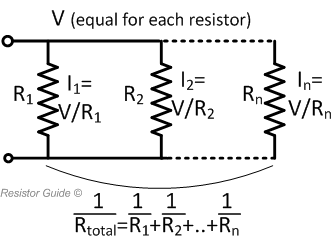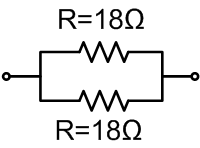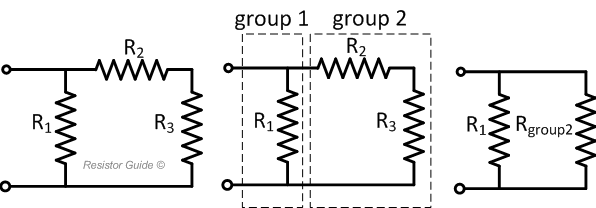How to calculate the equivalent resistance value for resistors in parallel?

Resistors are often connected in series or parallel to create more complex networks. An example of 3 resistors in parallel is shown in the picture above. The voltage across resistors in parallel is the same for each resistor. The current however, is in proportion to the resistance of each individual resistor. The equivalent resistance of several resistors in parallel is given by:
The current through each resistor is given by:
To quickly calculate the equivalent resistance value of two resistors in parallel, you can use the parallel resistor calculator.
example |
|
| A circuit designer needs to install a resistor with 9 ohms and can choose from the E-12 series of preferred values(.., 10, 12, 15, 18, 22, 27, 33, 39, 47, 56, 68, 82, ..). The value of 9 ohms is unfortunately not available in this series. He decides to connect to standard values in parallel with an equivalent resistance of 9 ohms. The equivalent resistance value for 2 resistors in parallel is calculated with these steps:
The above equation shows that if R1 is equal to R2 Req is half of the value of one of the two resistors. For a Req of 9 ohms, R1 and R2 should therefore have a value of 2×9=18 ohms. This happens to be a standard value from the E-series. As a solution finally, the designer connects two resistors of 18 ohms in parallel as shown in the figure right. |
 |
How to solve a network with resistors in parallel and series?
A more complex resistor network can be solved by systematic grouping of resistors. In the picture below three resistors are connected. Resistors R2 and R3 are connected in series. They are in parallel with resistor R1. To solve the network, the resistors are separated in two groups. Group 1 consists of only R1. Group 2 consists of R2 and R3.

The equivalent resistance of group 2 is easily calculated by the sum of R2 and R3:
This leads to the simplified circuit with two resistors in parallel. The equivalent resistance value of this circuit is easily calculated:
Solving more complex networks with Kirchhoff’s laws
With the rules for resistors in series and in parallel, also larger networks can be solved. For more complex networks, sometimes Kirchhoff’s laws can be used.